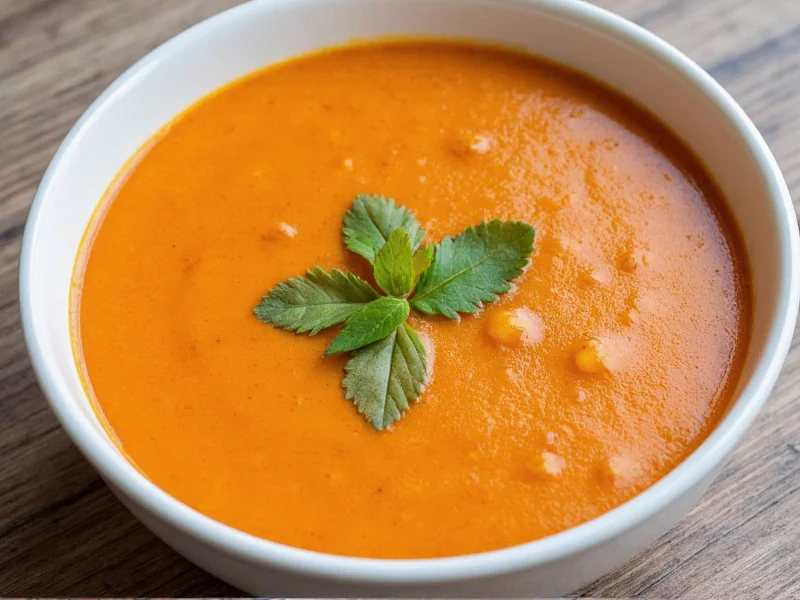When strategically incorporated into your eating routine, soup becomes a valuable weight management tool rather than a standalone solution. The key lies in understanding the science behind soup's satiety effects and implementing evidence-based strategies for maximum benefit. Research published in the journal Appetite demonstrates that participants who consumed a broth-based soup before lunch ate 20% fewer calories during that meal compared to those who didn't have soup.
The Science Behind Soup and Satiety
Soup's weight management benefits stem from several physiological mechanisms working together. The combination of liquid and solid components creates what researchers call "volume eating"—consuming larger portions with fewer calories. This triggers stretch receptors in your stomach while the liquid component increases gastric distension, sending stronger fullness signals to your brain.
A landmark study from Pennsylvania State University found that when participants consumed chicken rice soup containing 150 calories, they subsequently ate significantly fewer calories at their next meal compared to when they consumed an equivalent-calorie snack of solid food. The soup eaters consumed 134 fewer calories overall, demonstrating soup's unique advantage in calorie management.
Types of Weight-Loss Friendly Soups Compared
| Soup Type | Calories per Serving | Protein Content | Satiety Rating* | Best For |
|---|---|---|---|---|
| Clear Broth Vegetable | 60-80 | 2-3g | ★★★☆☆ | Pre-meal appetite control |
| Bean and Lentil | 150-180 | 8-10g | ★★★★★ | Main meal replacement |
| Tomato Basil | 100-120 | 3-4g | ★★★☆☆ | Light lunch option |
| Cream of Mushroom | 220-250 | 4-5g | ★★☆☆☆ | Occasional treat |
| Miso Soup with Tofu | 80-100 | 6-7g | ★★★★☆ | Evening meal starter |
*Satiety rating based on 5-point scale measuring fullness duration and hunger suppression
Strategic Soup Incorporation Techniques
Timing matters significantly when using soup for weight management. Consuming soup 20-30 minutes before your main meal allows time for your stomach to register fullness signals. Alternatively, replacing one high-calorie meal daily with a nutrient-dense soup can create a sustainable calorie deficit. The most effective approach combines both strategies—using soup as a starter for two meals while replacing one meal entirely.
When preparing weight-loss soups, focus on high-volume, low-energy-density ingredients. Fill at least 50% of your soup with non-starchy vegetables like broccoli, spinach, zucchini, and bell peppers. Include 15-20 grams of protein per serving through lean chicken, turkey, beans, or lentils to enhance satiety. Limit added fats to 1-2 teaspoons per serving, preferably from heart-healthy sources like olive oil.
Avoiding Common Soup Weight Loss Mistakes
Many people undermine soup's weight loss potential through common errors. Canned soups often contain excessive sodium—sometimes exceeding 1,000mg per serving—which can cause water retention and bloating. Cream-based soups frequently pack hidden calories from heavy cream and cheese that negate soup's calorie advantage. Another pitfall is adding high-calorie toppings like croutons, sour cream, or excessive cheese.
Research from the American Journal of Clinical Nutrition reveals that the temperature of soup affects its satiety properties. Warm soups (140-160°F) trigger stronger fullness signals than cold soups, making them more effective for appetite control. The study showed participants consuming warm soup ate 11% fewer calories at their next meal compared to those eating room-temperature soup.
Realistic Expectations for Soup-Based Weight Management
Soup should function as one component of a comprehensive weight management strategy, not a magic solution. Expect modest but sustainable results—incorporating soup properly might help create a 100-200 calorie daily deficit, translating to approximately 1-2 pounds of weight loss per month. This gradual approach aligns with medical recommendations for healthy, maintainable weight loss.
For optimal results, combine soup consumption with other evidence-based practices: maintain adequate protein intake throughout the day, incorporate strength training to preserve muscle mass, and prioritize sleep quality. Remember that individual responses vary based on metabolism, activity level, and overall dietary patterns. Consult with a registered dietitian to personalize soup incorporation into your specific nutritional needs.
How much weight can I realistically lose using soup as part of my diet?
When properly incorporated as part of a balanced eating plan, soup can help create a 100-200 calorie daily deficit. This typically translates to approximately 1-2 pounds of weight loss per month, which aligns with medical recommendations for sustainable weight management. Individual results vary based on overall diet, activity level, and metabolism.
What's the best time to eat soup for maximum weight loss benefits?
Research shows consuming a low-calorie broth-based soup 20-30 minutes before your main meal provides the greatest benefit, reducing subsequent calorie intake by up to 20%. Alternatively, replacing one high-calorie meal daily with a nutrient-dense soup can create a sustainable calorie deficit. The most effective approach combines both strategies for two meals while replacing one meal entirely.
Are canned soups effective for weight loss or should I make my own?
Most canned soups contain excessive sodium (often 800-1,000mg per serving) and hidden calories from cream or cheese. While convenient, they're generally less effective than homemade versions. If using canned options, choose low-sodium varieties under 150 calories per serving and enhance them with additional vegetables and lean protein. Homemade soups allow complete control over ingredients and portion sizes for optimal weight management.
Does the temperature of soup affect its weight loss properties?
Yes, research published in the American Journal of Clinical Nutrition shows warm soups (140-160°F) trigger stronger fullness signals than cold soups. Participants consuming warm soup ate 11% fewer calories at their next meal compared to those eating room-temperature soup. The warmth enhances gastric distension and activates temperature-sensitive receptors that contribute to satiety signaling.
Can I eat soup every day for weight loss without nutritional deficiencies?
Yes, you can eat soup daily for weight loss while maintaining nutritional balance, but variety is crucial. Ensure your soups contain diverse vegetables, adequate protein (15-20g per serving), and healthy fats. Rotate ingredients weekly to cover all essential nutrients. Pair soup meals with nutrient-dense sides like leafy green salads. Consult a registered dietitian to create a balanced soup-based eating plan that meets all your nutritional requirements.











 浙公网安备
33010002000092号
浙公网安备
33010002000092号 浙B2-20120091-4
浙B2-20120091-4